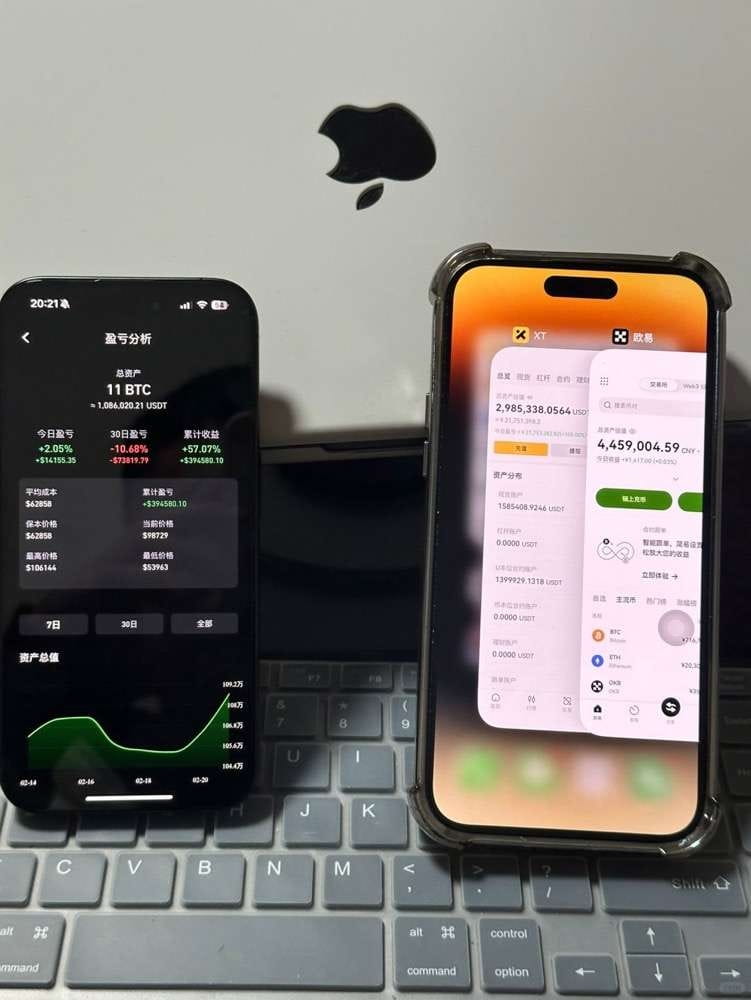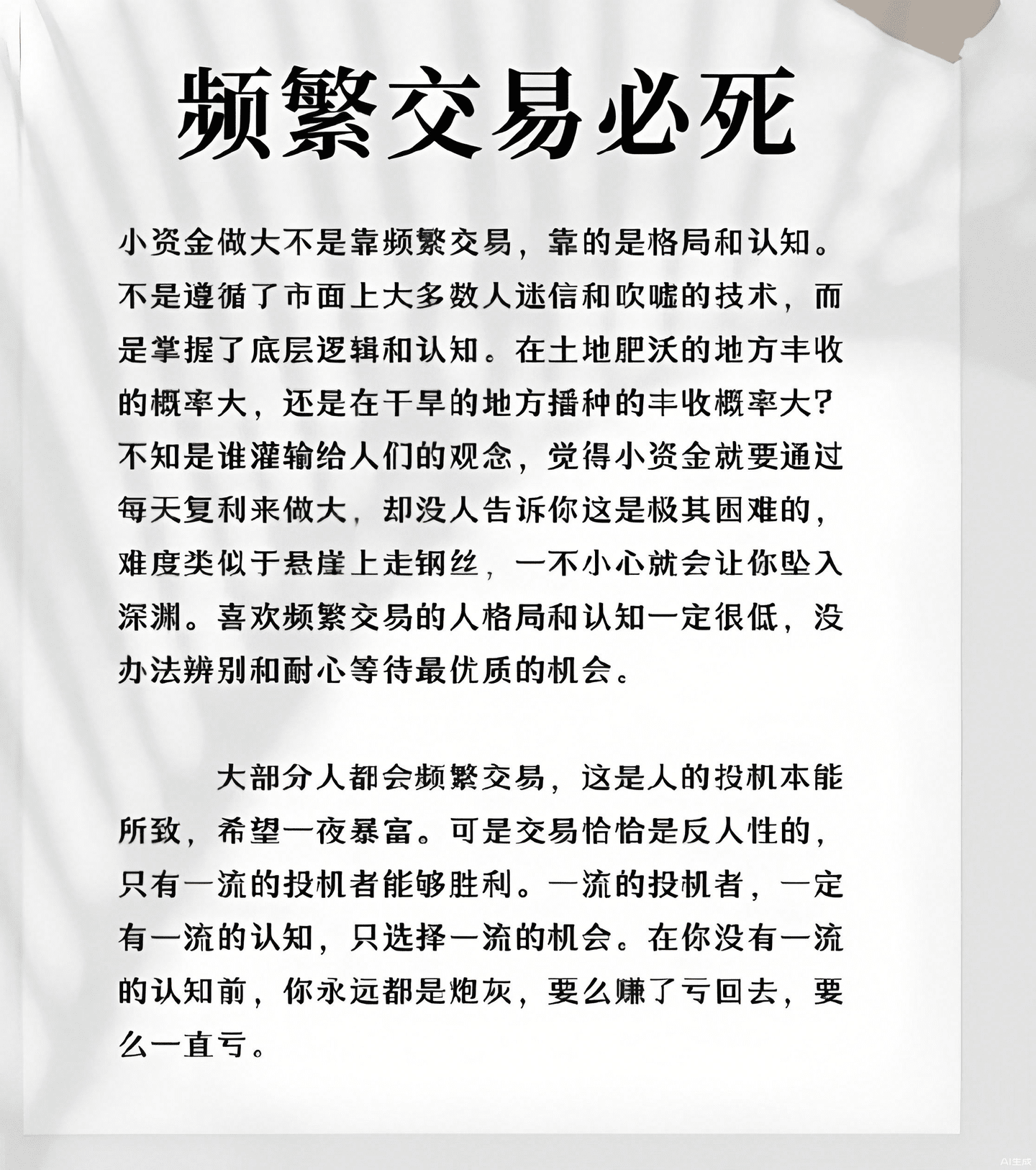How did I roll from 1000U to 530000U? (Real experience)
If you currently have 1000U in capital and want to make a name for yourself in the crypto space, what would you do?
Relying on luck, blindly chasing news, or gambling with closed eyes? I used to do this, resulting in losses that nearly left me without pants. Until later, I devised a rolling position strategy, steadily rolling from 1000U to 53000U in less than 5 months, without liquidation and without reckless gambling.
This is not a made-up story; it is the path I have genuinely walked.
If you are willing to spend 5 minutes looking at the experience below, it might be useful to you.
🔍 My rolling position logic is summed up in four words: Small Wins, Compounding.
In the beginning, I set a small goal: to earn 3~5% daily.
Do not underestimate this small profit; the power of compounding can be frightening. Because I only engage in high-certainty trades, my success rate can remain stable at over 70%, relying on these three points:
📌1. Find the rhythm: Follow the trend, do not go against the market.
Only take pullback opportunities in an upward trend (this is the simplest and most aggressive), resolutely avoid chasing highs and bottom fishing, and just eat 'the most stable part in the middle.'
📌2. Control positions: Only move half of the capital.
Never let each position exceed 50% of the total position; even if you judge incorrectly, there is still room for recovery. Gradually add to the profitable portion; if a loss occurs due to failure, there is no heartache—because only profits are lost.
📌3. Do not be greedy: Secure profits, daily settlement thinking.
Only do 1-2 trades a day, rest after making profits, to prevent sudden market backlash. Review every night; if wrong, write it down and continue optimizing the next day.
📈 Here are a few real operation snippets (just a part):
✅ On January 16, ETH broke through the consolidation area and went long: profit 85U.
✅ On February 5, ARB saw reduced trading volume and a buy point, entered quickly and exited quickly: profit 120U.
✅ On March 21, BNB broke through the triangle convergence and surged: profit 215U.
✅ On April 12, after the market was sideways for several days, it rebounded: profited from a main bullish wave, doubled in a single trade.
This rhythm of advancing gradually has taken me step by step from 1000U to 1800U to 3200U to 7100U...
Now, the account balance is over 53,000U, and I am still insisting on doing only two things: only taking opportunities I understand and strictly executing my plan.
🤫 Many people ask me: What signals are you really looking at? How do you judge when 'it's about to take off'? Where to buy and where to sell?

In early 2024, I faced liquidation due to high-leverage contracts, and my account was left with only 1000U. At that time, my mindset was on the brink of collapse: unwilling to exit but afraid of going to zero again, I stayed up every night staring at the market, trapped in a vicious cycle of 'wanting to make quick money but losing more urgently.'
Background: The starting point of hitting rock bottom.

In early 2024, I faced liquidation due to high-leverage contracts, and my account was left with only 1000U. At that time, my mindset was on the brink of collapse: unwilling to exit but afraid of going to zero again, I stayed up every night staring at the market, trapped in a vicious cycle of 'wanting to make quick money but losing more urgently.'
Turning Point: Three Discipline Strategies to Break the Deadlock.

Give up the fantasy of getting rich quickly, and use profits to nurture more profits.
∙ In the first month, only 10% of the capital (100U) was used for testing, focusing on BTC/ETH fluctuations; after making a profit, I withdrew the principal and only reinvested profits.
∙ For example: The first trade was a buy order for ETH at 2400; after 3 days, I profited 36%, and immediately used that 36U profit separately as new position capital, locking the original capital in place.
2. '3/3/4 Position Management Method' to combat risks.

∙ Each trade is divided into three batches: 30% for the initial position, 30% for adding during a pullback, and 40% reserved for extreme market conditions.
In March 2024, I ambushed the obscure coin ALPHA (which was not in the top 100 by market cap at the time) with an initial position of 30U, and after the doubling trend started, I took profits in batches, achieving a monthly profit of 5,200U.
Arbitrage based on information asymmetry, reject following the crowd.

∙ Monitor the main force's movements through on-chain data: I once discovered unusual large orders for a DeFi project (WLFI) on-chain, ambushed three days in advance, and profited from a 400% rise in the market.
Reject the 'K-Line War God' model: No more than 2 trades per day, with 80% of the time spent analyzing on-chain data and the fundamentals of projects.
Key Battle: From 14,000U to 87,000U in 28 days.
∙ Strategy: Identify major buying signals near SOL 145U, using a rolling position tactic: open the first position with 50X leverage to go long, and with every 5% increase, add the profit as a new position while also moving the stop loss line up.
∙ Mental Test: On the 5th day of holding, SOL dropped 12%, but the stop loss only triggered a profit withdrawal of 7%, preserving 93% of the position. On the 12th day, the main bullish wave started, ultimately yielding a full profit of 176U to 196U, and the account surged to 87,000U.
Darkest Moment: Greed Almost Destroyed Everything

When my account broke through 54,000U, I secretly went heavy on altcoins without my mentor's knowledge, trying to 'validate my logic,' resulting in a single-day loss of 43%. At that moment, I finally woke up: recovery depends not on a one-time gamble but on the repeated execution of discipline.
Final Outcome: Transformation of 300,000U∙

Time: Duration of 14 months (January 2024 - March 2025), average daily trading time reduced from 6 hours to 1 hour.
Core Mentality:
When capital ≤ 100,000U: Focus on airdrops, whitelists, and low market cap ambushes (as Shen Yu said, 'Use time to exchange for chips').
After breaking through 100,000U: Only do BTC/ETH coin-based trading, never short, and achieve an annualized 40% cash flow through DeFi arbitrage (such as dYdX staking).
Result: Account net worth of 302,000U, with 80% transferred to cold wallets, and the remaining funds continue to execute the rolling position strategy.
Bloody Lessons
Killing the 'inner demon' is more important than killing the market: 90% of failures are not due to lack of technique but rather succumbing to the 'gambler's mentality to recoup losses.'
Information > Technical Analysis: The K-lines seen by ordinary retail investors are 72 hours slower than those seen by the main force; on-chain data is the real alpha.
3. Replace emotions with rules: Set mechanical stop losses (single loss ≤5%), and take profits (if profit exceeds 20%, always withdraw the principal) to survive the bull market.

Why is deliberate practice necessary in trading?
Trading is a complex skill that involves technical analysis, fundamental analysis, risk management, and various other areas. Deliberate practice helps traders master these skills through repeated training and targeted learning. For instance, by extensively reading charts and analyzing historical data, traders can become more adept at identifying trends and patterns, thereby improving the accuracy of their decision-making.
2. Optimize Trading Strategies
Trading strategies need constant adjustments and optimizations. Deliberate practice through repeated testing and reviews helps traders discover shortcomings in their strategies and make improvements. For example, by simulating trades or backtesting, traders can verify their strategies under different market conditions and find the methods that suit them best.
3. Cultivating Discipline
Discipline in trading is crucial. Deliberate practice through setting clear goals and rules helps traders develop the habit of strictly executing their plans. For example, keeping a daily trading log to analyze the gains and losses of each trade gradually fosters the ability to adhere to rules and avoid emotional trading.
4. Overcoming Psychological Weaknesses
Common psychological weaknesses in trading include greed, fear, and overconfidence. Deliberate practice helps traders identify and overcome these weaknesses by simulating real trading environments. For example, through high-risk trades in simulated accounts, traders can experience emotional fluctuations without financial loss, thereby learning to control their emotions.
5. Accumulate Experience
Trading experience is the key to success. Deliberate practice through repeated practice helps traders accumulate valuable experience. For example, through extensive trading practice, traders can better understand market behavior and identify opportunities and risks under different market conditions.
6. Improve Reaction Speed
The market is changing rapidly, and traders need to make quick decisions. Deliberate practice through simulating fast-changing market environments helps traders improve their reaction speed and decision-making ability. For example, through high-frequency trading simulations, traders can train themselves to make accurate judgments in a short time.
7. Enhance Self-Confidence
Self-confidence is an important trait of successful traders. Deliberate practice helps traders build confidence through continuous small successes. For example, by gradually achieving small goals, traders can enhance their confidence in their abilities, making them more decisive in real trading.
8. Continuous Improvement
The market is constantly changing, and traders need to continuously improve. Deliberate practice through regular reviews and reflections helps traders continuously optimize their strategies and methods. For example, by reviewing trading records weekly, traders can identify potential issues and make adjustments.
Summary
Deliberate practice is the key for traders to enhance their skills, optimize strategies, overcome psychological weaknesses, and accumulate experience. Through systematic training and reflection, traders can gradually improve their trading level and ultimately achieve success in the market. Deliberate practice not only helps traders master techniques but also cultivates discipline and mental fortitude, laying a foundation for long-term stable profits.

Rules for short-term trading in the crypto market:
Pay attention to the trend after the market consolidation: when the coin price consolidates at a high level, it often reaches a new high; if it consolidates at a low level, it usually hits a new low again. Therefore, it is essential to wait until the direction of the trend is clear before taking corresponding actions, and one must not act blindly.
Do not trade during sideways movements: Most traders lose money because they cannot avoid this. During sideways phases, the market trend is unclear, and trading impulsively can easily lead to losses; one must learn to patiently wait.
Based on K-line operations: When choosing K-lines, consider buying on a bearish close; conversely, when there is a bullish close, it is time to sell.
Pay attention to the rhythm of declines and rebounds: when the decline slows down, the rebound is often also slow; conversely, when the decline accelerates, the rebound tends to be stronger. One should be adept at grasping these rhythm changes.
Use the pyramid buying method for building positions: players need to build positions according to the pyramid buying method, which is a relatively stable and reliable strategy in value investing in digital currencies, and it is worth following in practical operations.
In summary, the reasons for missing opportunities typically boil down to four common issues.

First, we are always lazy and averse to trouble.
Even when seeing Bitcoin prices continually hitting new highs, we are reluctant to actively understand. We wait to watch the spectacle with a mindset that it might crash at any moment. The root of this mindset lies in the fact that our desire for money is not so strong, causing us to miss various opportunities.
Secondly, we have an innate resistance to new things.

We always prefer familiar things and instinctively resist the unfamiliar. However, if we can combine the unfamiliar with the known, transforming it into something we are familiar with, we can more easily accept new things.
However, most people blindly criticize and ridicule Bitcoin without understanding it, considering it a bubble. This practice undoubtedly makes us miss opportunities for wealth. Only when we fully understand and recognize the value and potential opportunities of new things can we make wise decisions.
Additionally, there is a spirit of adventure, or a gambler's mindset.

Even if we fully recognize the investment value of Bitcoin, we still fear failure and are reluctant to invest too much money. This mindset limits our investment scale and potential returns.
We tend to listen to others' opinions rather than delve deeply into new things ourselves. This behavior not only makes us miss opportunities for wealth but also limits our personal growth and development.
If we cannot overcome these issues, even if another opportunity to get rich arises, we are very likely to miss it.
Trading is both a grand and meticulous task.

For example: Pursuing absolute highs and lows is overdoing it. Being vague about precision, why not proactively wear a condom? Perspective is knowing to set aside meaningless problems.
Win and keep quiet; lose and keep quiet. Showing off when you win is the beginning of your loss. A happy neighbor is a pain; do not wake it. Moreover, this mindset will make you focus on profits and losses rather than the system. The focus is not on how much you won or lost, but on how much you have grown. A solid trading system nurtures silently, and wealth will naturally come. Life is also speculation; be cautious and often reflect on your own mistakes.
Investing is not an industry where hard work is rewarded; in fact, it is often the opposite.

Remember, at any time, your operation may be wrong. But paradoxically, speculation is an absolute personal heroism endeavor. You must stick to yourself while also being able to let go of yourself and actively admit mistakes. How to balance this?
The road is difficult, the road is difficult, it is not about the mountains, nor about the water, but in the repeated fluctuations of the market.

Profit is finding a glimmer of possibility in the impossible, remaining calm between life and death. Therefore, speculation is life, it is only about giving and taking. Knowing when to stop leads to gains.

95% of profits come from 5% of trades; the key to trading success or failure lies in determination and perseverance.
Confidence and arrogance are two mindsets that look similar but yield vastly different results. Confidence or arrogance, the answer lies within your heart, and there is no need to answer others because your wallet will prove your right or wrong; use the parts of failure to prove your success, rather than using last time's bullish trend to prove your excellence!
When I first entered the crypto space, I made a lot of money during a bullish trend, which later proved to be a bad thing because I thought I was very capable. In the following market, I lost all my profits and almost went into debt because I believed I could find so-called doubling coins at any time; arrogance eroded my heart and concealed my incompetence, and I lost my perspective.
I value every losing trade I make. I often take all the 'painful' mistakes out of my memory and remind myself of the foolishness of the errors I made. I expect not to repeat them because I want to succeed and cannot take the road of failure again... My confidence comes from my failures! Few people are willing to truly confront their mistakes, and day after day, they repeat every trade, looking for easy picks, doubling down, making small profits and taking big losses, risking all their funds in uncertain market conditions, following the crowd, and refusing to stop the losses...
Setting stop losses and executing stop losses are two different things. The smarter a person is, the more they will hesitate; humans instinctively avoid risks, which is the real reason for losing money in the crypto market... To understand this principle, one must go through a life-and-death situation!
We cannot control the market, so disappointment from the market is inevitable. Therefore, trading can never achieve perfection. Striving for the perfect trade often leads us to dwell on past mistakes and creates hesitation and fear about the future. 'Perfectionism can make us lose our original balance.'
We never feel secure when facing the market; the market will not acknowledge our thoughts; it will always move in the direction it should go. This is the recognition that should exist! 'Thinking the market will definitely move in a certain way is merely wishful thinking on our part; the market does not care what we think!' Do not solely focus on trading techniques or think all day about how to make ten million from the market; we should balance our emotional and psychological thoughts.
Successful traders cannot rely solely on skills; only those who continuously learn, reflect inwardly, think, and seek intelligence have a chance of success...
A person progresses fastest not when everything is going smoothly but when they encounter setbacks. After a big bearish plunge, there is often a significant bullish rally. When you've lived long enough, you'll make all kinds of mistakes. Ultimately, successful people are often those who have gone through countless ups and downs... Those who have never experienced setbacks often fall out of the game in a single failure.
I am not a master and often misread the market; no one is a god in trading. As for operations, just be responsible for your own account; seeing things correctly can lead to losses; seeing things incorrectly can lead to profits. It is not necessary to catch every turning point to be considered impressive; some market profits can only be observed, not realized. Winning or losing without showing it is the realm of mastery.
In the current market, many friends are losing money in the crypto space, buying as prices drop and selling as prices rise, mainly due to a lack of correct trading models. To survive in the cutthroat crypto market, one must have a set of profitable strategies and self-protective discipline; it is essential to learn more profitable models, including Dragon Strike strategy, upward pullback strategy, main force control strategy, and capital compounding strategy, and to understand the market and its operational trajectory.